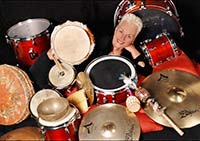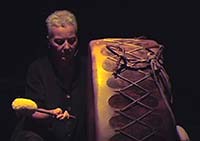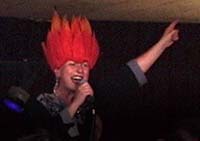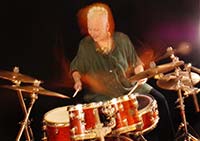 |
|||||
Gliding Into Old AgeSurfing documentary shows elderly folks still ride the waves Roy Earnest still remembers the winter day 13 years ago when he stood on an overlook near his Pacifica home, watching a 45-year-old, gray-haired friend surf choppy, 5-foot waves. Two 10-year-old neighborhood boys stood nearby, laughing at the surfer. "You know how old that guy is out there?'' one kid asked the other. "He's as old as my dad. He's 45!'' "Wow!'' answered his pal. "That's really old! I can't believe he remembers how to surf.'' Part amused and part dismayed, Earnest, who runs programs for seniors at San Francisco's Family Service Agency, set out to shatter the myths of aging using surfing as his metaphor. Together with director David L. Brown, he produced "Surfing for Life,'' a 68-minute documentary that shows some of California and Hawaii's most famous surfing legends riding the waves into their 70s, 80s and 90s. The film won the Audience Award and the Golden Maile Award for best documentary at the 1999 Hawaii International Film Festival. It will be released this month in the Bay Area. Narrated by Beau Bridges, the film spotlights John "Doc'' Ball, who at 93 is the oldest known American surfer. He shuns wetsuits while surfing in the frigid waters off the Northern California coast. Woody Brown, another subject of the film, became a Hawaiian big- wave surf rider in the 1940s and a celebrity in the yachting world for designing the modern catamaran in the 1950s. He surfs as often as possible near his home in Maui. "Us old-time fellows, we think of it a little differently,'' Brown said. "Now surfing's a competitive thing, but we went out there just for fun. We shared it, and that made it twice as good. "The sea is great medicine. It keeps you young, you know. I'm 88 and still surfing.'' Earnest, 46 and an avid surfer since age 8, knew it wasn't rare to see three generations out surfing the waves together. He also knew that staying active helps seniors remain vibrant. But he needed someone with experience behind the camera to help him bring his vision to the screen. In 1993, a colleague introduced him to David Brown, who for 15 years had made documentaries on such topics as the environment, nuclear war, radiation victims and toxic waste. "I was looking to do something more fun, more life-affirming, and this definitely fit the bill,'' said Brown, 52, of Brisbane. "The sport of surfing is so youth-identified, the idea of an 88-year-old surfer is instantly eye-opening.'' The two men interviewed editors of surfing magazines and scoured the beaches of California and Hawaii in search of seniors still riding the waves. They soon found 200 men who fit their criteria, and whittled their list to include names instantly recognizable to surfing buffs: Ball and Woody Brown; LeRoy "Granny'' Grannis, 81; Fred Van Dyke, 70; Rabbit Kekai, 79; John Kelly, 80; and Peter Cole, 69. Female senior surfers proved much harder to find. After six months of searching, the filmmakers found Anona Napolean, 60, a native Hawaiian, who won the prestigious Makaha International Surfing Championship in 1961 after making recovering from a paralyzing diving accident a year before. The filmmakers later tracked down Eve Fletcher, 73, who surfs in Southern California, and Shay Bintliff, 64, an emergency room physician in Hawaii who tells her secretary she has a "board meeting'' whenever she feels the need to surf. Earnest and David Brown filmed scores of interviews with their 10 stars and gathered footage of the surfers in their heyday. They filmed the surfers in action, and though some seniors now stick to small waves, it's clear they still feel joy just being out in the ocean. One of the documentary's most poignant moments comes when Van Dyke, a pioneer of big-wave surfing who wrote the classic surf book "30 Years of Surfing the World's Biggest Waves,'' explains tearily that he now fears surfing the huge waves he was once so identified with. Instead, he sticks to smaller waves, a decision that alienated him from his group of surfing buddies. "We didn't want to skirt over those issues,'' David Brown said. "Aging can be accompanied by a lot of struggles and a lot of pain -- psychological and physical pain. That resonates with a broad, nonsurfer audience who can identify with the challenges of life and the challenges of aging.'' It's important, Earnest said, for the film to show that Van Dyke and the others aren't "super elder jocks'' and that surfing and nonsurfing seniors alike can find pleasure as they age. "I just want to cheer people up about getting older,'' Earnest said. "They may not be able to surf the 20-foot waves, they may have to surf 3-foot waves, but they can still do what they love to do.'' After gathering reels of footage, the filmmakers hit a stumbling block. They'd maxed out their credit cards and couldn't fund the final editing process without outside sponsorship. Surfing companies didn't want to be associated with elders, and medical and gerontological foundations preferred to spend money on films about subjects like stroke prevention and nursing home abuse. "Both of my worlds sort of let me down,'' Earnest said. Eventually, they received funding from American Baptist Homes of the West, a California nonprofit that runs retirement communities throughout the western United States. The film premiered last year in Hawaii, with eight of its stars attending. It later sold out eight additional screenings on four islands. Woody Brown attended the premiere and said the filmmakers did "a wonderful job.'' A humble guy, he was surprised to be approached by fawning audience members after the screening. "They all told me, `Oh, you're an inspiration,' '' he said, adding that the film brought back a lot of memories about the day he learned to surf. "The waves said to me, `Woody Brown, if you could go out and build yourself a little board, you could ride across my face and we could both enjoy it,' '' he said with a laugh. Perhaps the film's most crowd- pleasing scene comes at the end when Ball jumps on a skateboard and cruises down his street in Eureka. Skateboarding helps him stay in shape, he said in a recent interview, though he can do it only "when the wife ain't looking.'' But surfing, he said, is the best exercise. It keeps his back straight and his heart pumping. It's the greatest feeling that you ever had,'' he said. "The sound of the water bumping against the nose of the board, it kind of stokes you. It's a thrill.''
|
|||||
Copyright © 2019, Pulse of Peace Pictures PO Box 1424 Mill Valley, CA 94942
|
|||||




